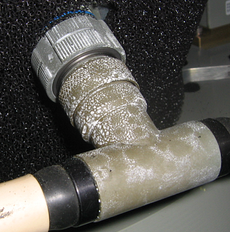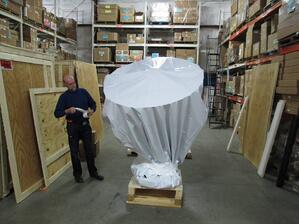 Cadmium, a naturally-occurring element, is one of several metallic coating materials which are electrochemically active and, therefore, used as sacrificial coatings to prevent corrosion. Typically they are applied to iron, steel, zinc, aluminum, and titanium alloys, as well.
Cadmium, a naturally-occurring element, is one of several metallic coating materials which are electrochemically active and, therefore, used as sacrificial coatings to prevent corrosion. Typically they are applied to iron, steel, zinc, aluminum, and titanium alloys, as well.
Cadmium coatings are used on hardware that must be subjected to harsh environments, especially where good corrosion resistance to marine or salt-laden atmospheres is required. Cadmium coatings are often employed in shipbuilding applications because of their high resistance to sea salt, and also in railroad, and ordnance applications. In addition, cadmium coatings have good corrosion fatigue properties as well as resistance to stress corrosion cracking, making them valuable in protecting high strength steel fasteners utilized in the aircraft industry.
The problem with cadmium coatings emerges when the coatings corrode and develop a bloom.
The problem with cadmium coatings emerges when the coatings corrode and develop a bloom. These bloom compounds are toxic, particularly in soluble and respirable forms, being more easily absorbed through inhaled dusts and fumes. Chronic Cadmium bloom dust or fume exposure can irreversibly damage the lungs, producing shortness of breath and emphysema. Fortunately, according to experts, the risk of absorption via dermal contact is negligible. According to OSHA, The Agency for Toxic Substances and Disease Registry estimates that more than 500,000 workers in the United States face exposure to cadmium each year. The International Agency for Research on Cancer lists cadmium metal and several of its compounds as carcinogens. Because of its toxicity, the use of cadmium is regulated by the U.S.Environmental Protection Agency and other regulatory control agencies. Reference.
 Quoted from a Raytheon senior principal engineer: “The overwhelming majority of reported occurrences of cadmium bloom on hardware have been associated with entrapment of acidic vapors together with the cadmium in a sealed enclosure. Acids can be formed in hardware shipping containers when humidity and moisture present in the container react with glue used in plywood or green wood (shipping pallet) to form corrosive formic acid vapors. Our root cause for cadmium bloom appears to fit this condition.” Intercept packaging was tested and has been continually proven in practical use to prevent cad bloom under these circumstances.
Quoted from a Raytheon senior principal engineer: “The overwhelming majority of reported occurrences of cadmium bloom on hardware have been associated with entrapment of acidic vapors together with the cadmium in a sealed enclosure. Acids can be formed in hardware shipping containers when humidity and moisture present in the container react with glue used in plywood or green wood (shipping pallet) to form corrosive formic acid vapors. Our root cause for cadmium bloom appears to fit this condition.” Intercept packaging was tested and has been continually proven in practical use to prevent cad bloom under these circumstances.

|
Liberty Packaging's video about corrosion:

|
And another about Intercept:

|
Intercept Technology Packaging products fit within a sustainability strategy because they are reusable, recyclable, do not contain or use volatile components (No VOCs, Not a VCI) and leave a smaller carbon footprint than most traditional protective packaging products.
Liberty Intercept Blog
Intercept Packaging Protects Against Cad Bloom
Posted by Elaine Spitz on Feb 23, 2015 2:22:00 PM
Cadmium coatings are used on hardware that must be subjected to harsh environments, especially where good corrosion resistance to marine or salt-laden atmospheres is required. Cadmium coatings are often employed in shipbuilding applications because of their high resistance to sea salt, and also in railroad, and ordnance applications. In addition, cadmium coatings have good corrosion fatigue properties as well as resistance to stress corrosion cracking, making them valuable in protecting high strength steel fasteners utilized in the aircraft industry.
Liberty Packaging's video about corrosion:
And another about Intercept:
Intercept Technology Packaging products fit within a sustainability strategy because they are reusable, recyclable, do not contain or use volatile components (No VOCs, Not a VCI) and leave a smaller carbon footprint than most traditional protective packaging products.
Topics: cad bloom, industrial packaging, innovation in packaging
Popular Posts
Aluminum Does Rust, Just Not the Way You're Thinking
Corrosion via Corrugate
A Look at Packaging Costs
Leave a Comment